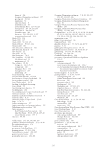3 1 The Lake Eyre Basin – one of the world’s great desert river systems Richard T. Kingsford Introduction The Lake Eyre Basin dominates central Australia, covering about a seventh of the continent – the heart of our land mass (Kingsford et al. 2014 Fig. 1.1). Only ~60 000 people live in this vast area (Measham and Brake 2009), with the majority concentrated in its major towns such as Alice Springs (~25 000), Longreach (~3400) and Winton (1600 Fig. 1.1). The rivers of the Lake Eyre Basin connect the top to the bottom and the east to west of the basin, mostly flowing north to south to reach the amazing Kati Thanda-Lake Eyre in South Australia (Fig. 1.2). Small rivers and creeks, high in the catchment, run into the large rivers which join with other rivers and creeks as they flow south to Kati Thanda-Lake Eyre. River water stays within the Lake Eyre Basin, either flowing onto its floodplains, into waterholes and lakes, seeping into the ground, transpiring from the vegetation or evaporating. It is a system formed over millennia, from a once mighty river where megafauna roamed its banks, including 3 m long diprotodonts, giant kangaroos (2 m high), the large flightless bird Genyornis newtoni (2 m high), the giant goanna Megalania prisca (5.5 m long) and the marsupial lion Thylacoleo carnifex (2 m long) (Habeck-Fardy and Nanson 2014). About 100 000 years ago, this basin had much more water than today, supporting a contrasting environment, when the lake was 25 m deep at today’s lowest point (Habeck-Fardy and Nanson 2014). By ~35 000 years ago, where Kati Thanda-Lake Eyre currently lies, Lake Dieri, a massive freshwater lake three times the size of today’s predominantly salty lake, dominated the landscape. Long-gone aquatic animals lived here, including platypus, dolphins and even four flamingo-like species. At 40 000–50 000 years ago, Aboriginal people established themselves in central Australia, living off the land and its rivers (Smith 2013 Tobler et al. 2017), which formed major trade routes to other river basins. They survived major changes in the climate as the continent became considerably drier and deserts formed. Extinction struck the megafauna and most of the large freshwater animals (Cohen et al. 2015). Aboriginal peoples knew their country, moving along the rivers with their permanent waterholes, and supplementing their water supplies from natural groundwater wells (Hercus and Clarke 1986) and plants. They lived on edible plants such as nardoo Marsilea drummondi, and harvested fish and waterbirds from the rivers. Ducks were caught with nets across the rivers. On the Coongie Lakes (Fig. 1.1), Yandruwandha people corralled colonies of pelican chicks (Fig. 1.3) until they were large enough to be harvested (Reid 2009). This strong connection to country continues today for many Aboriginal people who live within the Lake Eyre Basin.
Downloaded from CSIRO with access from at 216.73.216.172 on Nov 24, 2025, 10:25 PM. (c) CSIRO Publishing

















































































































































































































































































